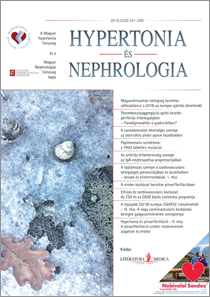The eLitMed.hu medical portal uses computer cookies for convenient operation. Detailed information can be found in the Cookie-policy.
Hypertension and nephrology - 2018;22(06)
Content
[PAX2: lotium et visus sine pace]
[The autosomal dominant papillorenal syndrome results from primarily de novo mutations of PAX2. It encodes a transcription factor expressed in the kidney, urinary tract, nervous system, eye and the ear. Its haploinsufficiency causes primarily hypoplastic and hyperreflective kidney, or other forms of CAKUT. The clinical appearance may be dominated by nephrotic-range proteinuria with focal segmental glomerulosclerosis. The renal survival rate is highly variable: most of the recognized cases lead to ESRD during the first four decades of life. PAX2 mutations cause typical optic papillary alterations, most frequently papillary dysplasia. In contrast to the name of the syndrome, one fourth of the affected patients do not develop ocular involvement. Hearing impairment is associated in less than 10% of the patients. The affected members of the five families that we identified with PAX2 loss-of-function mutations, developed end-stage renal disease during the 2-4. decades of life.]
[Prognostic role of arterial stiffness in IgA nephropathy]
[Background: Arterial stiffness has a prognostic role in chronic cardiovascular diseases. Pulse wave velocity (PWV) determined by the carotid-femoral pulse detection is accepted as a gold standard method. Further diagnostic procedures are in use to assess the arterial stiffness including the finger photoplethysmography. The prognostic role of this method is limited in chronic renal diseases. The goal of our investigation was to determine the prognostic significance of the stiffness index (SIDVP) measured by the photoplethysmographic method in IgA nephropathy. Patients and methods: One hundred and three histologically proved IgA nephropathy patients with chronic kidney disease stage 1-4 were investigated (67 male, 36 female, 45 ± 11 years) and followed for an average 65 (6-107) months. The stiffness index was determined by the volume alteration of the digital artery during the cardiac cycle (Pulse Trace system, Micro Medical, Gilingham, Kent, UK). The primary combined end point was total mortality, major cardiovascular events (stroke, myocardial infarction or cardiovascular procedure, for example revascularisation) plus achieving end stage renal disease. The secondary end points were cardiovascular and renal end points alone. Results: The patients with increased stiffness index (> 10 m/s) had significantly more combined primary end point events (10/60 vs. 19/43, P = 0.015). In case of the secondary end points the renal end points were significantly more frequent in patients with higher stiffness index. Stiffness index has also proved to be an independent predictor on survival from other cardiovascular risk factors (age, hypertension, diabetes, obesity, lipid disturbances and decrease of renal function) using the Cox regression model in IgA nephropathy. Every 1 m/s increase in stiffness index resulted a 17% gain in the occurrence of the combined primary end point. Conclusions: Stiffness index determined by finger photoplethysmography is an eligible parameter to assess the prognosis in IgA nephropathy. Increased stiffness index in IgA nephropathy seems to be a good prognostic tool for identification of higher risk patients.]
[The new European ESH/ESC guidelines. Part III. Pharmacotherapeutic strategies on treatment of patients with high cardiovascular risk based]
[The new joint hypertension guidelines of the European Society of Hypertension and European Society of Cardiology will simultaneously be published in August, 2018 in the Journal Hypertension and European Heart Journal on the diagnostics, evaluation, treatment and follow up of hypertensive patients. This guidelines put emphasis on definition, and therapeutic strategies in patients with high cardiovascular risk. In this paper I summarise the cardiovascular risk factors and put emphasis on possibilities of reduction of cardiovascular risk.]
[Hypertension and atrial fibrillation. Part 2. Basic methods of screening atrial fibrillation]
[Early detection of PF, especially short-term “paroxysmal aritmia”, is very important primarily in older individuals (over 65 ys), especially those with heart disease, hypertension or diabetes. Two methods are known for the early detection of PF: In one (regular screening) making 12-lead ECG examination for individuals over the age of 65 at fix times. The other (opportunistic screening) means that every person over the age of 65, whenever he or she percieves any complains, the physician will experience the pulse of the patient and in case of arrhythmia the EKG is made.]
1.
Clinical Neuroscience
[Headache registry in Szeged: Experiences regarding to migraine patients]2.
Clinical Neuroscience
[The new target population of stroke awareness campaign: Kindergarten students ]3.
Clinical Neuroscience
Is there any difference in mortality rates of atrial fibrillation detected before or after ischemic stroke?4.
Clinical Neuroscience
Factors influencing the level of stigma in Parkinson’s disease in western Turkey5.
Clinical Neuroscience
[The effects of demographic and clinical factors on the severity of poststroke aphasia]1.
2.
3.
4.
5.



